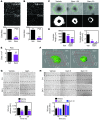Metabolic stress regulates cytoskeletal dynamics and metastasis of cancer cells
- PMID: 23921130
- PMCID: PMC3998961
- DOI: 10.1172/JCI67841
Metabolic stress regulates cytoskeletal dynamics and metastasis of cancer cells
Abstract
Metabolic reprogramming is an important driver of tumor progression; however, the metabolic regulators of tumor cell motility and metastasis are not understood. Here, we show that tumors maintain energy production under nutrient deprivation through the function of HSP90 chaperones compartmentalized in mitochondria. Using cancer cell lines, we found that mitochondrial HSP90 proteins, including tumor necrosis factor receptor-associated protein-1 (TRAP-1), dampen the activation of the nutrient-sensing AMPK and its substrate UNC-51-like kinase (ULK1), preserve cytoskeletal dynamics, and release the cell motility effector focal adhesion kinase (FAK) from inhibition by the autophagy initiator FIP200. In turn, this results in enhanced tumor cell invasion in low nutrients and metastatic dissemination to bone or liver in disease models in mice. Moreover, we found that phosphorylated ULK1 levels were correlated with shortened overall survival in patients with non-small cell lung cancer. These results demonstrate that mitochondrial HSP90 chaperones, including TRAP-1, overcome metabolic stress and promote tumor cell metastasis by limiting the activation of the nutrient sensor AMPK and preventing autophagy.
Figures










Similar articles
-
Impact of the integrin signaling adaptor protein NEDD9 on prognosis and metastatic behavior of human lung cancer.Clin Cancer Res. 2012 Nov 15;18(22):6326-38. doi: 10.1158/1078-0432.CCR-11-2162. Epub 2012 Oct 4. Clin Cancer Res. 2012. PMID: 23037767
-
Control of tumor bioenergetics and survival stress signaling by mitochondrial HSP90s.Cancer Cell. 2012 Sep 11;22(3):331-44. doi: 10.1016/j.ccr.2012.07.015. Cancer Cell. 2012. PMID: 22975376 Free PMC article.
-
Phosphorylation of ULK1 by AMPK regulates translocation of ULK1 to mitochondria and mitophagy.FEBS Lett. 2015 Jul 8;589(15):1847-54. doi: 10.1016/j.febslet.2015.05.020. Epub 2015 May 14. FEBS Lett. 2015. PMID: 25980607
-
Inhibition of the mitochondrial Hsp90 chaperone network: a novel, efficient treatment strategy for cancer?Cancer Lett. 2013 Jun 10;333(2):133-46. doi: 10.1016/j.canlet.2013.01.045. Epub 2013 Jan 31. Cancer Lett. 2013. PMID: 23376257 Review.
-
Heat shock protein 90 inhibition in lung cancer.J Thorac Oncol. 2008 Jun;3(6 Suppl 2):S152-9. doi: 10.1097/JTO.0b013e318174ea3a. J Thorac Oncol. 2008. PMID: 18520302 Free PMC article. Review.
Cited by
-
Dissecting the Dual Role of AMPK in Cancer: From Experimental to Human Studies.Mol Cancer Res. 2015 Jul;13(7):1059-72. doi: 10.1158/1541-7786.MCR-15-0068. Epub 2015 May 8. Mol Cancer Res. 2015. PMID: 25956158 Free PMC article. Review.
-
Effect on the liver cancer cell invasion ability by studying the associations between autophagy and TRAP1 expression.Oncol Lett. 2018 Jul;16(1):991-997. doi: 10.3892/ol.2018.8774. Epub 2018 May 22. Oncol Lett. 2018. PMID: 29963174 Free PMC article.
-
Targeting cellular respiration as a therapeutic strategy in glioblastoma.Oncotarget. 2023 May 4;14:419-425. doi: 10.18632/oncotarget.28424. Oncotarget. 2023. PMID: 37141415 Free PMC article.
-
Autophagy and epithelial-mesenchymal transition: an intricate interplay in cancer.Cell Death Dis. 2016 Dec 8;7(12):e2520. doi: 10.1038/cddis.2016.415. Cell Death Dis. 2016. PMID: 27929542 Free PMC article. Review.
-
Mitochondria in chronic obstructive pulmonary disease and lung cancer: where are we now?Biomark Med. 2017 May;11(6):475-489. doi: 10.2217/bmm-2016-0373. Epub 2017 Jun 9. Biomark Med. 2017. PMID: 28598223 Free PMC article. Review.
References
Publication types
MeSH terms
Substances
Grants and funding
LinkOut - more resources
Full Text Sources
Other Literature Sources
Medical
Research Materials
Miscellaneous

